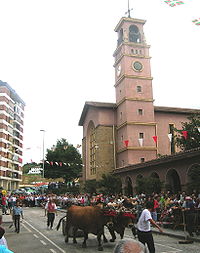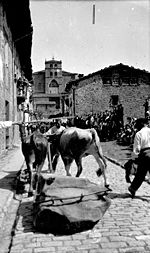- Idi probak
-
The idi probak (Basque for "oxen tests", also called idi demak (oxen wagers)) are the most popular form of Basque dragging games. It involves oxen, usually a pair, dragging a rock from one side of a square to another. In Spanish this sport is called arrastre de piedra (stone dragging) or prueba de bueyes (oxherd test) and concours de bœf (oxen competition) in French.
Contents
Location
Although idi probak can in theory be carried out on any reasonably flat surface, the preference is to conduct them on specially constructed proba tokiak (test places). They are ideally:
- 22.3m wide, with 8 lanes of 2.79m
- cobbled to reduce friction
- on totally flat ground
- between 22-28m long although this may vary depending on the space available
Some have a paved surface but these are unpopular because the oxen find it more difficult to get a good grip on a smooth surface.
Rules
The oxen used in idi probak usually weight between 500-650 kg although oxen weighing more than 1400 kg have also been used in competitions. During the year, they are taking for walks of around 5 km in the hills and mountains daily to maintain their strength. They are also trained in dragging rocks and working in teams during the year and many baserris (Basque farmhouses) still have their own rocks for dragging.
As all oxen in the Basque Country, they are yoked at the horns.
The rocks, called probarriak or "test rocks", are roughly rectangular, slightly narrower at the front end with a hole for attaching the chain. The weight varies from town to town and may be between 1500-4000 kg or higher. For example, in Tolosa the stones weight 4000 kg, in Gernika 4500 kg. The town of Berriatua has a rock in the proba toki weighing 5250 kg but hasn't been used since 1950 mainly because today the preference is to see the teams complete more circuits rather than drag larger rocks. If an oxen is over the weight limit (usually around 1100 kg), extra weights are put on the probarriak. For every kilo the ox is over, 1.5 kg are added to the rock.
The goal of the competition is to complete as many plaza (the distance between the two ends of the proba toki) as possible within a given space of time. Today this is normally half an hour but has been known to last up to two hours.
Straws are drawn to decide the order in which the teams compete. To go first is not considered fortunate as there will be no reference as to the performance of the other teams yet.
The start is announced with a whistle. The itzaina (ox-herder) and the akuilutzaileak (goaders) now have to steer the oxen along the track. The itzaina leads the team from the front, the akuilutzaile tries to steer both the oxen and the rock from the back. Ideally a team completes a full plaza without stopping as it costs a lot of energy to get the rock moving. They also try to keep to the middle of the track because if a rock touches or goes over the side demarcation this is seen as a foul and the team has to restart from the place the rock went over the line. Once the other side is reached, the team has to turn around and return to the sart line.
At the end of the competition, the referees announce the results both in plazak and meters raced.
The number of prodders can vary depending on the bets or the rules for the event. Usually a team of two is used but there are also events where only one ox is used, which is called uztarri bakarrean or "single yoke".
Women and idi probak
Traditionally a male dominated sport, women have begun to take part in idi probak in recent years as they have in other Basque sports.
History
As so many Basque sports, the idi proba has its roots in the rural communities. Oxen were in widespread use due to the hilly topography of the Basque Country to which oxen are better suited than horses or mules.
Traditionally the oxen were used as working oxen during the year and put onto light duty and receiving a special diet only in the run-up to the probak. Today few people keep working oxen and most are kept and trained solely for the probak.
Doping and animal welfare
The popularity of the sport and the associated heavy betting has not left the sport unscathed. The Basque oral tradition records cases of animal maltreatment with trainers spurning on their teams too harshly and such cases also occur today.
There has also been a number of cases of doping. Although the number of cases is low, the Basque regional governments started introducing anti-doping measures in 1997 and created the office of Official Veterinarian in 2005 to help ensure good practice.
See also
References
- Rural Basque Sports
- The Basque Federation for Rural Sports
- Kulki (a sports culture organisation)
- Department of Culture (in Basque and Spanish)
- Agirre, R. Juegos y deportes vascos, Auñamendi, Donostia 1978
- Etxegoien, J. Orhipean, Xamar 1996
- Feliu, C. Gure Herria: Tradiciones y Costumbres del País Vasco
Categories:- Basque culture
- Basque sport
- Cantabrian culture
Wikimedia Foundation. 2010.



